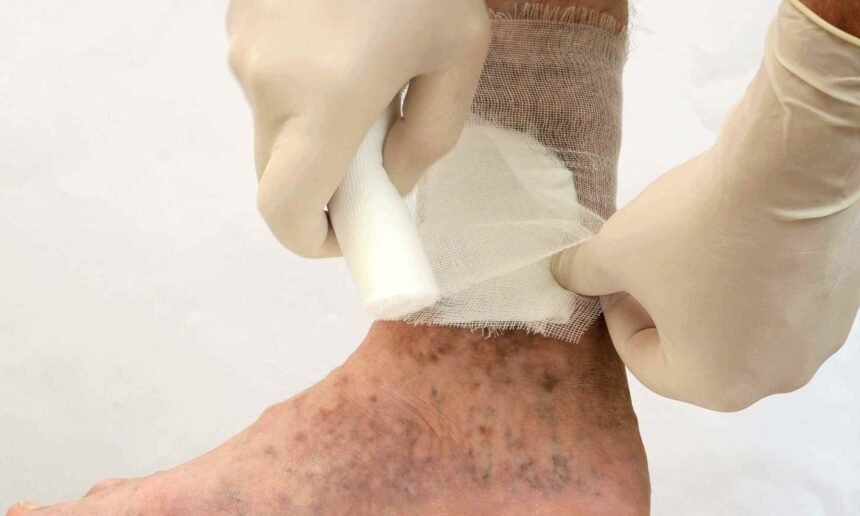Arterial ulcers are a serious medical condition caused by poor blood circulation, often due to blocked or narrowed arteries. If left untreated, these ulcers can lead to severe complications, including infection and tissue necrosis. Understanding the risk factors for arterial ulcers and how to reduce them is essential for prevention and effective management. This blog explores the key risk factors and provides practical strategies to minimize their impact.
These ulcers typically result from poor circulation, often linked with other chronic conditions. If you’re unfamiliar with the symptoms, our arterial ulcer symptoms and treatment guide can help you spot early warning signs.
What Are Arterial Ulcers?
Arterial ulcers, also known as ischemic ulcers, develop when there is inadequate blood supply to the extremities, primarily due to peripheral artery disease (PAD). These ulcers commonly appear on the toes, feet, and lower legs and are characterized by a punched-out appearance, dry wound bed, and severe pain.
Major Risk Factors for Arterial Ulcers
Several factors contribute to the development of arterial ulcers. These risk factors can be classified into modifiable and non-modifiable categories.
Modifiable Risk Factors
These are lifestyle-related risk factors that can be controlled or altered to reduce the risk of arterial ulcers.
- Peripheral Artery Disease (PAD)
- PAD is a leading cause of arterial ulcers. It occurs due to plaque buildup in arteries, restricting blood flow to the limbs.
- Smoking
- Smoking damages blood vessels, reduces oxygen supply, and accelerates atherosclerosis (artery hardening).
- Diabetes
- High blood sugar levels damage blood vessels, leading to poor circulation and delayed wound healing.
- Hypertension (High Blood Pressure)
- Increased arterial pressure causes vascular damage, making it difficult for wounds to heal.
- High Cholesterol Levels
- Excessive cholesterol leads to arterial blockages, restricting blood supply to extremities.
- Obesity
- Excess weight increases stress on blood vessels, worsening circulation problems.
- Sedentary Lifestyle
- Lack of physical activity contributes to poor blood circulation and increases the risk of PAD.
- Poor Nutrition
- A diet high in processed foods, unhealthy fats, and sugar can worsen arterial health.
While managing these risks is crucial, knowing how to distinguish between ulcer types is equally important. Here’s how to tell the difference between arterial and venous ulcers based on symptoms and underlying causes.
Non-Modifiable Risk Factors
These factors cannot be changed but should be monitored closely to reduce their impact.
- Age
- Older adults are more prone to arterial diseases due to natural wear and tear of blood vessels.
- Genetics and Family History
- A family history of cardiovascular diseases increases the likelihood of developing arterial ulcers.
- Gender
- Men are more likely to develop arterial ulcers than women, though the risk for women increases after menopause.
How to Reduce the Risk of Arterial Ulcers
1. Manage Underlying Health Conditions
- Control diabetes by maintaining stable blood sugar levels through a healthy diet and medication.
- Monitor and manage high blood pressure with lifestyle changes and prescribed medications.
- Reduce cholesterol levels through a balanced diet and exercise.
2. Quit Smoking
- Stopping smoking improves circulation, reduces inflammation, and slows down artery damage.
3. Adopt a Heart-Healthy Diet
- Increase intake of fruits, vegetables, lean proteins, and whole grains.
- Avoid processed foods, trans fats, and excessive salt to maintain vascular health.
4. Exercise Regularly
- Engage in low-impact activities like walking, swimming, or cycling to boost circulation.
- Strengthen leg muscles to promote blood flow to extremities.
5. Maintain a Healthy Weight
- Losing excess weight reduces pressure on arteries, improving overall circulation.
6. Proper Foot Care
- Inspect feet daily for cuts, ulcers, or color changes.
- Keep feet clean, moisturized, and protected to prevent infections.
- Wear comfortable, well-fitting shoes to prevent pressure sores.
7. Medication and Medical Interventions
- Take prescribed blood thinners or cholesterol-lowering medications as recommended.
- Undergo vascular procedures like angioplasty or bypass surgery if needed to restore blood flow.
Conclusion
Understanding the risk factors for arterial ulcers is the first step toward prevention and management. By making lifestyle changes, managing underlying conditions, and seeking medical care when necessary, individuals can significantly reduce their risk of developing arterial ulcers. If you experience symptoms like leg pain, slow-healing wounds, or poor circulation, consult a healthcare professional immediately.


Leave a Reply